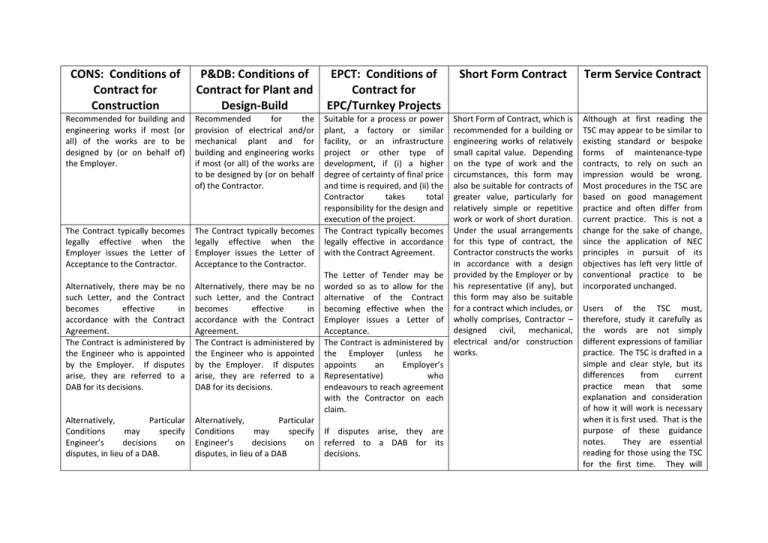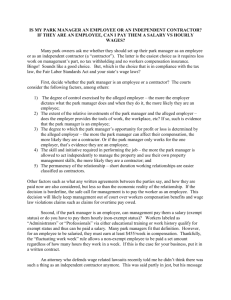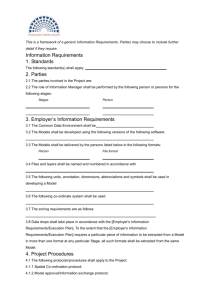Comparison Types of Fidic contract forms - cat 2
advertisement

CONS: Conditions of Contract for Construction P&DB: Conditions of Contract for Plant and Design-Build EPCT: Conditions of Contract for EPC/Turnkey Projects Short Form Contract Term Service Contract Recommended for building and engineering works if most (or all) of the works are to be designed by (or on behalf of) the Employer. Recommended for the provision of electrical and/or mechanical plant and for building and engineering works if most (or all) of the works are to be designed by (or on behalf of) the Contractor. The Contract typically becomes legally effective when the Employer issues the Letter of Acceptance to the Contractor. The Contract typically becomes legally effective when the Employer issues the Letter of Acceptance to the Contractor. Suitable for a process or power plant, a factory or similar facility, or an infrastructure project or other type of development, if (i) a higher degree of certainty of final price and time is required, and (ii) the Contractor takes total responsibility for the design and execution of the project. The Contract typically becomes legally effective in accordance with the Contract Agreement. Alternatively, there may be no such Letter, and the Contract becomes effective in accordance with the Contract Agreement. The Contract is administered by the Engineer who is appointed by the Employer. If disputes arise, they are referred to a DAB for its decisions. Alternatively, there may be no such Letter, and the Contract becomes effective in accordance with the Contract Agreement. The Contract is administered by the Engineer who is appointed by the Employer. If disputes arise, they are referred to a DAB for its decisions. Short Form of Contract, which is recommended for a building or engineering works of relatively small capital value. Depending on the type of work and the circumstances, this form may also be suitable for contracts of greater value, particularly for relatively simple or repetitive work or work of short duration. Under the usual arrangements for this type of contract, the Contractor constructs the works in accordance with a design provided by the Employer or by his representative (if any), but this form may also be suitable for a contract which includes, or wholly comprises, Contractor – designed civil, mechanical, electrical and/or construction works. Although at first reading the TSC may appear to be similar to existing standard or bespoke forms of maintenance-type contracts, to rely on such an impression would be wrong. Most procedures in the TSC are based on good management practice and often differ from current practice. This is not a change for the sake of change, since the application of NEC principles in pursuit of its objectives has left very little of conventional practice to be incorporated unchanged. Alternatively, Particular Conditions may specify Engineer’s decisions on disputes, in lieu of a DAB. Alternatively, Particular Conditions may specify Engineer’s decisions on disputes, in lieu of a DAB The Letter of Tender may be worded so as to allow for the alternative of the Contract becoming effective when the Employer issues a Letter of Acceptance. The Contract is administered by the Employer (unless he appoints an Employer’s Representative) who endeavours to reach agreement with the Contractor on each claim. If disputes arise, they are referred to a DAB for its decisions. Users of the TSC must, therefore, study it carefully as the words are not simply different expressions of familiar practice. The TSC is drafted in a simple and clear style, but its differences from current practice mean that some explanation and consideration of how it will work is necessary when it is first used. That is the purpose of these guidance notes. They are essential reading for those using the TSC for the first time. They will The Contractor designs (but only to the extent specified) and executes the works in accordance with the Contract (which includes the Specification and Drawings) and the Engineer’s instruction Interim and final payments are certified by the Engineer, typically determined by measurement of the actual quantities of the works and applying the rates and prices in the Bill of Quantities or other Schedules. Other valuation principals can be specified in Particular Conditions. The General Conditions allocate the risks between the parties on a fair and equitable basis: taking account of such matters as insurability, sound principals of project management, and each party’s ability to foresee, and mitigate the effect of, the circumstances relevant to each risk. The Contractor provides plant, and designs (except as specified) and executes the other works, all in accordance with the Contract, which includes his Proposal and the Employer’s Requirements. Interim and final payments are certified by the Engineer, typically determined by reference to a Schedule of Payments. The Contractor provides plant, and designs and executes the other works, ready for operation in accordance with the Contract, which includes his Tender and the Employer’s Requirements. Interim and final payments are made without any certification: typically determined by reference to a Schedule of Payments. The alternative of measurement of the actual quantities of the works and applying the rates and prices in a Schedule of Prices can be specified in Particular Conditions. The General Conditions allocate the risks between the parties on a fair and equitable basis: taking account of such matters as insurability, sound principles of project management, and each party’s ability to foresee, and mitigate the effect of, the circumstances relevant to each risk. The alternative of measurement of the actual quantities of the works and applying the rates and prices in a Schedule of Prices can be specified in Particular Conditions. Disproportionately more risks are allocated to the Contractor under the General Conditions. Tenderers will require more data on hydrological, subsurface and other conditions on the Site, to the extent that this data is relevant to the particular type of works, and more time to review the date and evaluate such risks. continue to be useful in training people coming into the management of service contracts in how to make best use of the TSC. The TSC is also essentially different from other forms of contract in the NEC family of contracts. It has been designed for use in a wide variety of situations – not restricted to construction. It is essentially a contract for a Contractor to provide a service (not limited to a professional or construction service) to an Employer from a starting date and throughout a service period. It uses established NEC procedures and wording as much as possible. It is designed for managing and providing a service – not for managing a project. The service may be provided continuously over the period of the contract or on a task-by-task call-off basis. The TSC should not be used for very minor services, such as those provided by a sole trader involving his or her own work and little technical resource of skill and equipment. The service is usually provided on the Employer’s premises but may not be. The service may include physical work, such as cleaning, painting or other maintenance, but may not do. In the public sector, the TSC is designed to be used for all contracted-out services, whether including a physical content or not. Examples of its use in the construction sector may be wide ranging and include: maintenance of highways in a particular area. periodic inspection of bridges and reporting, cleaning of streets in an urban area, refuse collection and disposal, collection and recycling of domestic waste materials, maintaining public parks and landscape areas, maintaining heating, lighting and ventilation of buildings, maintenance of a canal and servicing its leisure facilities, snow clearing of highways, maintaining a nuclear power station, providing security personnel for an installation, site or building. Examples of other and more complex applications are providing ambulance services for a group of hospitals, servicing and maintaining airport terminal buildings, providing commercial television programmes in a geographic area, providing data processing services by a computer systems company, Public-Private Partnership enterprises, perhaps alongside construction projects under the ECC, e.g. the construction of a new prison and subsequent running of the prison. It is important to appreciate that the TSC is not a contract for a project. The principle of the TSC is that the contracting to maintain an existing state A for a period of time is a service. Contracting to achieve a state B when the present state is state A is not a service – it is a project. However, a modest amount of improving the condition of an asset can sensibly be included in a TSC. Maintenance for the purpose of the TSC includes renewal and replacement of things which have become worn out, and hence may include some ‘betterment’ of particular items.




